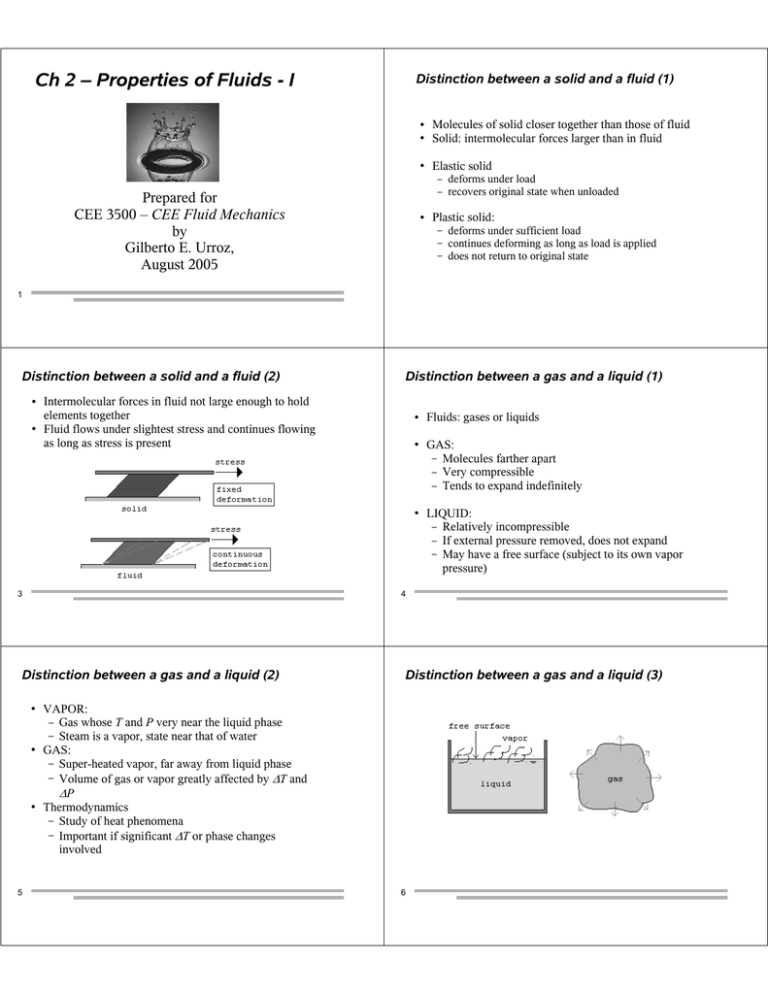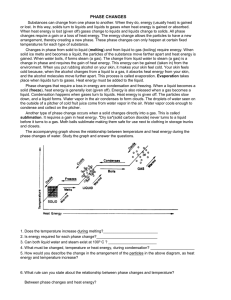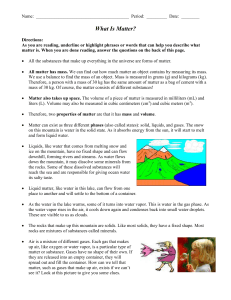Ch 2 – Properties of Fluids - I
advertisement

Ch 2 – Properties of Fluids - I Distinction between a solid and a fluid (1) ● ● ● Molecules of solid closer together than those of fluid Solid: intermolecular forces larger than in fluid Elastic solid – – Prepared for CEE 3500 – CEE Fluid Mechanics by Gilberto E. Urroz, August 2005 ● deforms under load recovers original state when unloaded Plastic solid: – – – deforms under sufficient load continues deforming as long as load is applied does not return to original state 1 Distinction between a solid and a fluid (2) ● ● Distinction between a gas and a liquid (1) Intermolecular forces in fluid not large enough to hold elements together Fluid flows under slightest stress and continues flowing as long as stress is present ● ● ● 3 GAS: – Molecules farther apart – Very compressible – Tends to expand indefinitely LIQUID: – Relatively incompressible – If external pressure removed, does not expand – May have a free surface (subject to its own vapor pressure) 4 Distinction between a gas and a liquid (2) ● ● ● 5 Fluids: gases or liquids Distinction between a gas and a liquid (3) VAPOR: – Gas whose T and P very near the liquid phase – Steam is a vapor, state near that of water GAS: – Super-heated vapor, far away from liquid phase – Volume of gas or vapor greatly affected by ΔT and ΔP Thermodynamics – Study of heat phenomena – Important if significant ΔT or phase changes involved 6 Density, Specific Weight ● ● ● Specific Volume, Specific Gravity Density, or mass density, ρ [rho] = mass per unit volume (kg/m3, slug/ft3) ● Specific weight, γ [gamma] = weigth per unit volume (N/m3, lb/ft3 = pcf) ● 8 Compressible and incompressible fluids ● ● ● – ● ● Compressibility of liquids (1) Compressible: variable density Incompressible: constant density No real incompressible fluid exists, assumed so if Δρ is small as P changes, e.g., – ● Liquids usually Gases if ΔP small relative to absolute pressure ● Liquid compressibility important in pressure waves Air: – Incompressible: ventilating system, fly < 250 mph – Compressible: high-velocity pipe, fly > 760 mph (speed of sound) 9 Compressibility of liquids (2) Bulk (volume) modulus of elasticity, Ev (kPa-abs, psia) Ev represents the Δp required to produce a unit change in specific volume (Δv/v) ● Ev = f(T,p) for liquids [e.g.,see Table 2.1, p. 17] ● Use absolute pressures, thus, units: psia, kPa abs 10 Compressibility of liquids (3) ● ● ● 11 Specific gravity for a liquid is the dimensionless ratio where ρL = density of liquid, ρW = density of water at a standard temperature (either 4oC, or 60oF) ● For gases, the reference density is not standard. It must be specified. ● See Sample problems 2.1, 2.2, pp. 15-16 Related by 7 Specific volume, v: volume per unit mass (ft3/slug, m3/kg) 12 For a fixed mass of liquid at constant temperature, the bulk modulus does not change much on a moderate range of temperature (e.g., see Table 2.1, p. 17, for water). In this case (refer to figure in previous slide), we can write: See Sample Problem 2.3, p. 18. Specific weight of liquids ● ● ● ● See Table 2.2, p. 20, for γ for common liquids at 68oF (20oC) and standard sea-level pressure with g = 32.2 ft/sec2 (9.81 m/s2) Specific weight of liquids: – Varies only slightly with pressure – May vary considerably with temperature See Figure 2.1, p. 20, γ = f(p,T ) For water at atmospheric pressure conditions at sea level, see Table A.1, Appendix A, p. 732 13 14 Property relations for perfect gases (1) ● Property relations for perfect gases (2) Perfect gases: gases with constant specific heats that obey the perfect-gas law: p/ρ = p⋅v = R⋅T or = ● g p RT ● p = abs pres., ρ = density, v = 1/ρ, T = abs temp., R = gas constant ● ● For air, R = 1715 ft/(sec2⋅oR) = 287 m2/(s2⋅K) ● Equations: equations of state, or property relations 15 16 Property relations for perfect gases (3) ● ● Property relations for perfect gases (4) Dalton's law of partial pressures: each gas in a mixture exerts its own pressure as if the other were not present. Thus, each gas' pressure is governed by its own equation of state. Water vapor as naturally occurring in the atmosphere has a low vapor pressure. Treat it as an ideal gas with ● where n>0, and its value depends on the process. ● ● Process equation: another important relationship for perfect gases: p⋅v n = p1⋅v1n = const., or (p/p1) = (ρ/ρ1)n = const. R = 2760 ft/(sec2⋅oR) = 462 m2/(s2⋅K) 17 Avogadro's law: all gases under same p, T, g have the same number of molecules per unit of volume. Thus, γ ~ M (molar mass, or molecular weight). Universal gas constant, R0 = M⋅R R0 = 49 709 ft⋅lb/(slug-mol⋅oR) R0 = 8 312 N⋅m/(kg-mol⋅K) For real (nonperfect) gases, R0 = M⋅z⋅R, where z = compressibility factor, z = f(p,T), and the equation of state is now p/ρ = p⋅v = z⋅R⋅T For vapors reaching the liquid phase, obtain properties from specific tables (e.g., steam tables) ● ● 18 Isothermal (constant temperature) process, n = 1 Adiabatic (no heat transfer) process. Isentropic (frictionless, reversible, adiabatic) process, n = k = cp/cv, the c's are the heat capacities at constant p and at constant v Property relations for perfect gases (5) ● ● ● See Table A.5 for values of k. For air at usual temps., k = 1.4. Differentiate p⋅v n = const., for variable v and p : n⋅p⋅v n-1 dv + vn dp = 0, then use definition of Ev: Other useful relations: n−1 T2 v = 1 T1 v2 ● Compressibility of perfect gases (5) = 2 1 n−1 p = 2 p1 Ev = n⋅ n⋅p n−1 n See Sample Problem 2.5, p. 24. 19 ● For an isothermal process, n = 1, and Ev = p ● For an isentropic process, n = k, and Ev = k⋅ k⋅p ● See discussion in p. 25, and Sample Problem 2.6, pp. 26-27 20 Standard atmosphere (1) U.S. Standard atmosphere temperature Troposphere: Troposphere: 0-11.02 km (36 200 ft) ● ● ● ● ● ►T Need to standardize aircraft instruments. ICAO Standard Atmosphere (1964), extends up to 32 km (105 000 ft) Stratosphere: Stratosphere: 9 km (30 000 ft) thick ISO Standard Atmosphere (1973), extends up to 50 km (164 000 ft) Mesosphere: Mesosphere: ►T increases to a max. of -2.5oC (27.5oF) at about 50 km (165 000 ft or 31 mi) Ionosphere: Ionosphere: See Figure 2.2, p. 28 ►T 22 U.S. Standard atmosphere - pressure P decreases quite rapidly and smoothly to almost zero at an altitude of 30 km (98 000 ft) Temperature, pressure, and other parameters of the ICAO Standard Atmosphere in Table A.3, Appendix A Outside of an airplane flying at 30,000 ft, the ICAO Standard Atmosphere indicates: ►T = -47.832oF ►P = 4.372 psia (32% of sea-level pressure) remains constant at -56.5oC (-69.7oF) ►T U.S. Standard Atmosphere (1976), extends up to 86 km (282 000 ft or 53.4 mi) 21 23 decreases linearly at a rate of -6.5oC/km 24 again decreases






